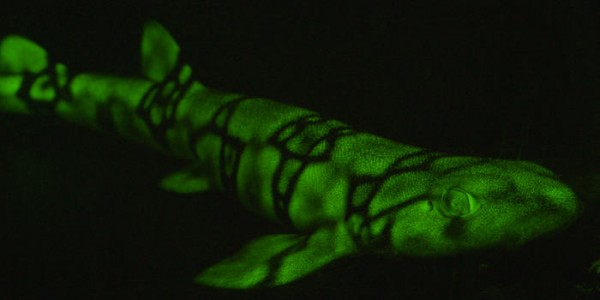By Ana Verayo, | April 27, 2016

A green biofluorescent chain catshark (Scyliorhinus retifer)
A remarkable new study reveals the life of sharks dwelling in abysmal depths of the ocean, and how they emit a unique glow in deep waters to attract a potential mate. With a special camera, scientists obtained an exciting view of these marine animals that remained mostly hidden due to the lack of light in this type of underwater habitat.
Like Us on Facebook
Scientists from the American Museum of Natural History investigated this natural glow in the dark phenomenon or biofluorescence among two catshark species, deep below 1,640 feet underwater. Since only blue light can penetrate their habitat, the sharks emit a greenish biofluorescent glow from their skin where the patterns appear different for male and females of every species.
According to author of the study, biology professor David Gruber from Baruch College, this new study also marks the first biofluorescence study to link deep water sharks' vision to their ability to emit fluorescence.
He explains that since catsharks are naturally fluorescent, this study now reveals how this helps them easier to spot other members of the same shark species. The catsharks' eyes already adapted to this dim environment and entirely blue habitats in a span of 400 million years of evolution.
Using a special "shark eye" camera that creates a simulation of their vision, the team saw evidence the many different kinds of fish can absorb any type of blue light in their environment where they release it again in eerie glows of neon green, red and orange hues.
During the experiments, the researchers designed specific lighting that simulates ocean light where they recorded the sharks' activities through this camera with green filters that can block blue light and combined these with the shark eye camera to experience how sharks perceive their marine habitat.
Using mathematical models, the shark eye camera generated images with contrasting patterns of the glowing sharks which increased in fluorescence the deeper they swam. As the water became deeper, it became bluer which made the fluorescence even sharper than in shallow waters.
The results suggest that the sharks use this kind of light as a type of communication where this glowing or biofluorsescnence works as an indicator for the catsharks to know if they are of the same species or family. This new study is published in the journal Scientific Reports.
-
Use of Coronavirus Pandemic Drones Raises Privacy Concerns: Drones Spread Fear, Local Officials Say

-
Coronavirus Hampers The Delivery Of Lockheed Martin F-35 Stealth Fighters For 2020

-
Instagram Speeds Up Plans to Add Account Memorialization Feature Due to COVID-19 Deaths

-
NASA: Perseverance Plans to Bring 'Mars Rock' to Earth in 2031

-
600 Dead And 3,000 In The Hospital as Iranians Believed Drinking High-Concentrations of Alcohol Can Cure The Coronavirus

-
600 Dead And 3,000 In The Hospital as Iranians Believed Drinking High-Concentrations of Alcohol Can Cure The Coronavirus

-
COVID-19: Doctors, Nurses Use Virtual Reality to Learn New Skills in Treating Coronavirus Patients







